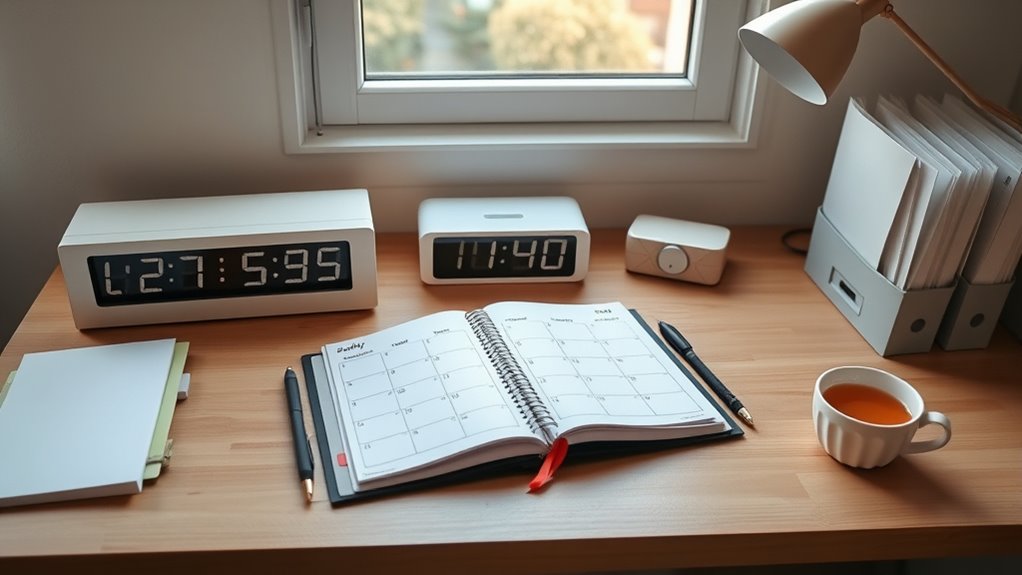To organize effectively with BPD, establish clear routines and boundaries using visual aids and flexible scheduling to create stability. Maintain a supportive environment by setting consistent expectations and open communication, while developing crisis protocols for emergencies. Focus on education for support networks and regularly adjust strategies based on progress. Prioritizing emotional regulation and self-care is key. If you want to learn more about creating a supportive plan, keep exploring these helpful tips.
Key Takeaways
- Establish consistent daily routines with visual aids to provide stability and reduce anxiety.
- Develop clear crisis management protocols and establish safe spaces for emergencies.
- Use respectful communication and visual reminders to reinforce boundaries and promote understanding.
- Educate support networks regularly and monitor progress to adapt strategies effectively.
- Incorporate emotion regulation techniques and self-care activities to enhance emotional stability.
Establish Clear and Consistent Routines

Why is establishing clear and consistent routines so important for managing BPD? It provides you with a sense of stability and predictability, which helps reduce anxiety caused by uncertainty. A reliable routine creates a foundation for emotional regulation, making it easier to handle mood swings. Sticking to a daily schedule for sleep, meals, and therapy supports your coping strategies and promotes self-care. Using visual planners or checklists can reinforce your routine, giving you a sense of achievement and control. Consistency builds trust—not only in yourself but also in your relationships—since predictable behavior helps prevent feelings of abandonment or rejection. When your routine becomes a stable anchor, managing BPD symptoms becomes more manageable, and you gain confidence in maintaining emotional balance daily. Additionally, establishing projected daily activities can help you anticipate and prepare for upcoming challenges, further reinforcing your routine. Incorporating emotion regulation techniques and understanding emotional triggers into your daily schedule can enhance your ability to maintain stability. Recognizing the importance of behavioral consistency can reinforce positive habits and reduce impulsivity. Developing self-monitoring strategies can also support ongoing awareness of your progress and areas needing adjustment.
Create a Supportive and Safe Environment

Creating a supportive and safe environment is essential for managing BPD because it helps reduce feelings of uncertainty and emotional instability. You can foster this by maintaining clear boundaries and expectations, which lessen anxiety and prevent misunderstandings. You are trained on data up to October 2023. Self Watering Plant Pots utilize a reservoir system that allows plants to absorb water as needed, providing a helpful analogy for creating consistent support structures. Establishing predictable routines provides consistency and comfort, helping minimize triggers and emotional reactions. Consistent routines also help in managing emotional responses more effectively. Incorporating secure and reliable communication channels ensures that feelings are expressed clearly and misunderstandings are minimized, further reinforcing emotional safety. Communicating with calmness and clarity to build trust and guarantee emotional safety. Validating feelings without judgment encourages openness and strengthens your connection. Open dialogue about emotions and concerns promotes emotional expression and creates a sense of security.
Set and Communicate Boundaries Effectively

Setting and communicating boundaries effectively is essential for managing BPD, as it helps establish respect and predictability in relationships. To do this, you should:
- Clearly define your boundaries and communicate them calmly and consistently, reducing misunderstandings. clear boundary-setting Recognizing your limits aids in preventing emotional overwhelm and fosters a sense of control. You can also incorporate techniques like self-awareness to better understand your emotional responses and needs.
- Use “I” statements to express your limits without blame, fostering trust and respect.
- Reinforce boundaries early and often, especially during calm moments, to build a sense of safety.
- Remember that embracing boundaries can also involve acknowledging your own needs and feelings, which supports emotional well-being. emotional well-being
- Recognizing the importance of healthy boundaries can strengthen your ability to set limits effectively and maintain emotional stability.
Be specific about acceptable behaviors and be prepared to adjust boundaries as needed. consistent boundaries Maintaining consistency, even during challenging reactions, reinforces trust and creates a predictable environment.
Develop Emergency and Crisis Protocols

Developing effective emergency and crisis protocols is crucial for ensuring prompt and safe responses during BPD-related mental health crises.
Creating clear, step-by-step crisis protocols that outline immediate emergency actions for situations like self-harm or suicidal thoughts can significantly improve response times and outcomes. Incorporating training on recognizing warning signs and understanding appropriate intervention steps ensures that support persons can act swiftly and effectively. Training support persons and staff to recognize warning signs and access crisis intervention resources swiftly is essential. Establishing designated safe spaces and communication channels so individuals can discreetly seek help during episodes fosters trust and immediate support. Collaborate with mental health professionals to develop personalized crisis plans that include contact information, coping strategies, and emergency contacts. Including legal considerations in crisis planning helps ensure compliance with mental health laws and protects all parties involved. Additionally, understanding crisis intervention protocols can help responders provide more effective and compassionate support during emergencies. Involving individuals with lived experience in the planning process can also provide valuable insights into effective response strategies. Incorporating knowledge about good grief can help in understanding and addressing the complex emotional responses that may arise during crises, ensuring more compassionate and comprehensive support. Regularly review and update these protocols to reflect new best practices, legal requirements, and feedback from those with lived experience, ensuring your response remains effective and responsive during mental health crises.
Promote Open and Respectful Communication

To promote open and respectful communication, focus on active listening and validating feelings, which build trust and understanding. Using beneficial ingredients like collagen and hyaluronic acid in eye patches can also serve as a reminder to be mindful of the ingredients in products we choose, ensuring they align with our skin needs. Additionally, being aware of the essential oils that support calming and soothing effects can help create a more relaxed environment conducive to honest dialogue. Remember to respect personal boundaries, creating a safe space where honest dialogue can happen without fear. Paying attention to support hours for various services can also help plan conversations during more accommodating times, reducing stress and fostering openness.
Active Listening Techniques
Active listening is essential for fostering open and respectful communication, especially when interacting with individuals who’ve BPD. To improve your communication skills, focus on these key techniques:
- Use empathy and validation by saying things like, “I understand how you feel,” to build trust.
- Engage fully through active listening—maintain eye contact, nod, and use open body language to show respect.
- Clarify and paraphrase what’s been said to guarantee understanding and avoid miscommunication.
Calm and Clear Speech
Using calm and clear speech is essential for fostering a safe and respectful environment when communicating with individuals who’ve BPD.
Calm speech helps de-escalate emotional episodes and builds emotional stability, making conversations more productive.
Clear communication, using straightforward language, reduces misunderstandings and minimizes triggers.
Speaking in a respectful tone promotes trust, encouraging open sharing without fear of judgment.
Maintaining a consistent and gentle tone reinforces stability and predictability, which are vital for trust and emotional safety.
Avoid sudden changes in volume or tone, as they can overwhelm or trigger emotional responses.
Respect Personal Boundaries
Respect personal boundaries is fundamental to fostering open and respectful communication, especially with individuals who’ve BPD. When you honor boundaries, you create an environment of trust and emotional safety.
To do this effectively:
- Listen actively and acknowledge limits without pressure, respecting personal space.
- Use calm, non-judgmental language during sensitive conversations, promoting healthy interactions.
- Clearly define and reinforce boundaries through consistent dialogue, reducing misunderstandings.
Utilize Visual Aids and Reminders

Visual aids and reminders are powerful tools for managing emotions and maintaining stability with BPD. They help you understand your feelings and stay grounded during difficult moments.
Using visual aids like charts, diagrams, and color-coded reminders makes it easier to recognize triggers and practice emotional regulation. Visual schedules and cue cards provide clear, consistent cues that reinforce boundaries and coping strategies, reducing impulsivity.
Displaying reminders in visible places acts as grounding tools, helping you stay centered during emotional distress. Visual prompts also assist in tracking triggers and progress, boosting self-awareness.
Incorporating these visual supports into your daily routine creates predictability and safety, helping you build trust in yourself and your environment. These tools can profoundly enhance your ability to manage your emotions effectively.
Incorporate Flexibility in Scheduling and Tasks

Building on the idea of visual aids and reminders, adding flexibility to your schedule can considerably improve emotional stability.
You can do this by:
- Adjusting your schedule with flexible scheduling during emotional fluctuations, allowing you to manage stress triggers effectively.
- Making task modifications or taking breaks when needed to prevent overstimulation and emotional overload.
- Exploring remote work options to create a calming environment that aligns with your personal needs.
Educate Staff and Encourage Ongoing Learning

To effectively support individuals with BPD, it’s vital to educate staff and promote ongoing learning about the disorder. Prioritize staff education through mental health training, webinars, workshops, and online courses focused on BPD awareness.
Share up-to-date mental health resources and literature to dispel myths and deepen understanding. Incorporate BPD topics into regular staff training and professional development sessions to guarantee continuous learning.
Encourage participation in peer support groups and mental health forums, fostering a community of shared knowledge. Organization tips include creating a culture that values ongoing education and empathy.
Monitor and Adjust Strategies Regularly

Regularly monitoring and adjusting strategies is vital to providing effective support for individuals with BPD. To do this successfully, you should:
- Review and update support plans based on changes in symptoms and needs.
- Gather feedback from the person with BPD and their support network to identify effective strategies.
- Track progress over time with tools like mood diaries to inform necessary adjustments.
Maintaining flexibility is essential—be prepared to modify boundaries, communication approaches, or resources as the person’s mental health evolves.
Schedule consistent check-ins with mental health professionals to ensure your strategies stay aligned with treatment goals.
Frequently Asked Questions
What Are the 3 C’s for BPD?
The 3 C’s for BPD are essential to understand because they help you navigate the challenges without feeling guilty or responsible. You didn’t cause the behavior, so don’t blame yourself.
You can’t cure or control the disorder, so focus on supporting with compassion and boundaries.
What Is the Best Strategy in the Management of BPD?
Managing BPD is like tending a delicate garden—you need patience and careful attention. The best strategy combines evidence-based therapies like Dialectical Behavior Therapy (DBT), which help you develop emotional regulation skills.
Set consistent boundaries, seek validation, and stay calm during emotional storms. Early intervention, ongoing therapy, and medication if needed work together to stabilize moods.
Building trust and support are essential seeds for growth and resilience.
At What Age Does BPD Peak?
You might wonder when BPD peaks, and research shows it generally occurs between ages 18 and 25. During this time, emotional instability and impulsivity are most intense.
However, as you get older, especially after age 30, symptoms tend to decrease. Early treatment can make a difference, helping you manage symptoms better over time.
Keep in mind, individual experiences vary, so your journey might be unique.
How to Stop Spiraling in BPD?
When you feel yourself spiraling with BPD, recognize early warning signs like intense emotions or negative thoughts.
Use grounding techniques such as deep breathing or mindfulness to calm down.
Create a crisis plan with coping strategies and trusted contacts to reach out to.
Limit triggers by setting boundaries and avoiding overwhelming situations.
Practice self-compassion, remind yourself these feelings are temporary, and give yourself space to recover and regain emotional stability.
Conclusion
So, despite all these tips, remember that no plan is foolproof—your organization might still have its moments of chaos. But hey, that’s just life with BPD, right? Embrace the mess, celebrate small wins, and keep tweaking your approach. After all, the only real constant is change, and sometimes, the best organization tip is simply to laugh when things don’t go as planned. You’ve got this—mess and all.









